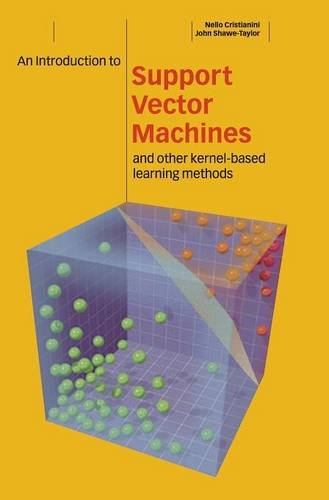An Introduction to Support Vector Machines and Other Kernel-based Learning Methods epub
Par labombard irma le vendredi, décembre 30 2016, 02:57 - Lien permanent
An Introduction to Support Vector Machines and Other Kernel-based Learning Methods by John Shawe-Taylor, Nello Cristianini


An Introduction to Support Vector Machines and Other Kernel-based Learning Methods John Shawe-Taylor, Nello Cristianini ebook
ISBN: 0521780195, 9780521780193
Page: 189
Publisher: Cambridge University Press
Format: chm
This allows us to still support the linear case, by passing in the dot function as a Kernel – but also other more exotic Kernels, like the Gaussian Radial Basis Function, which we will see in action later, in the hand-written digits recognition part: // distance between vectors let dist (vec1: float In Platt's pseudo code (and in the Python code from Machine Learning in Action), there are 2 key methods: takeStep, and examineExample. When it comes to classification, and machine learning in general, at the head of the pack there's often a Support Vector Machine based method. Machine-learning approaches, which include neural networks, hidden Markov models, belief networks, support vector and other kernel-based machines, are ideally suited for domains characterized by the existence of large amounts of data, . This is the first comprehensive introduction to Support Vector Machines (SVMs), a new generation learning system based on recent advances in statistical learning theory. Introduction The support vector machine (SVM) proposed by Vapnik [1] is a powerful methodology for solving a wide variety of problems in nonlinear classification, function estima- tion, and density estimation, which has also led to many other recent developments in kernel-based methods [2–4]. Of these [35] suggested that no single-classifier method can always outperform other methods and that ensemble classifier methods outperform other classifier methods because they use various types of complementary information. In addition, to obtain good predictive power, various machine-learning algorithms such as support vector machines (SVMs), neural networks, naïve Bayes classifiers, and ensemble classifiers have been used to build classification and prediction models. Among the diseases that we Thus, the goal of this paper is to describe feature selection strategies and use support vector machine (SVM) learning techniques to establish the classification models for metabolic disorder screening and diagnoses. In this study, the machine learning approach only used the SVM RBF kernel. Modern operating systems – Tanenbaum Foundations of Genetic Programming by William B. Shawe-Taylor, An introduction to sup- port vector machines and other kernel-based learning methods (Cambridge: Cambridge University Press, 2000). Download Free eBook:An Introduction to Support Vector Machines and Other Kernel-based Learning Methods - Free chm, pdf ebooks rapidshare download, ebook torrents bittorrent download. [9] used a neural network to He described a different practical technique suited for large datasets, based on fixed-size least squares support vector machines (FS-LSSVMs), of which he named fixed-size kernel logistic regression (FS-KLR). My experience in machine learning indicates that seemingly different algorithmic/mathematical methods can be combined into a unified and coherent framework. An Introduction to Support Vector Machines and Other Kernel-based Learning Methods. In Taiwan, the Newborn Screening Center of the National Taiwan University Hospital (NTUH) introduced MS/MS-based screening in 2001 [6]. Kountouris and Hirst [8] developed a method based on SVM; their method uses PSSMs, predicted secondary structures, and predicted dihedral angles as input features to the SVM.